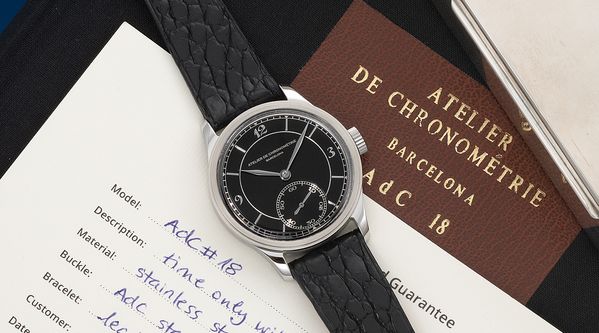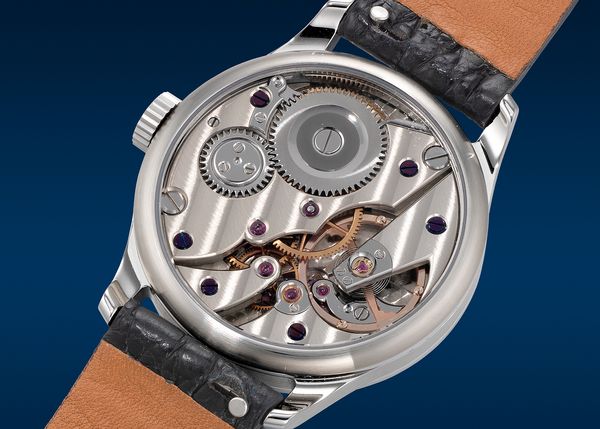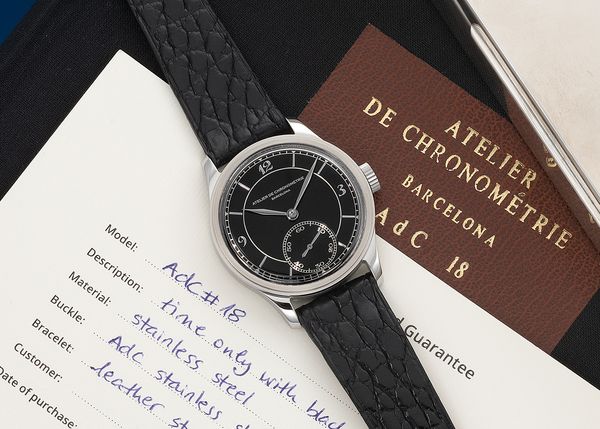The Hong Kong Watch Auction: XVI takes place on May 13 and 14, at our new Asia headquarters in the West Kowloon Cultural District. The auction includes more than 200 of the world's finest watches. We'll be highlighting a number of the most interesting lots and stories featured in the sale over the next few weeks, including the Atelier de Chronométrie watch featured here.
– By Logan Baker
Atelier de Chronométrie is a small high-end watchmaking firm with three employees based in the surprising Spanish coastal city of Barcelona. They’ve produced no more than 10 watches per year since being founded in 2015, and they recently announced their first in-house movement after previously focusing entirely on updating and reworking vintage chronometer ébauche movements.
I first heard about the company a few years ago, and I was surprised to learn about this new independent operation based far away from the European horological heartlands of Switzerland and Saxony. I’ve been curious to handle one of their watches ever since; luckily, the Hong Kong Watch Auction: XVI provided the perfect opportunity, when a wonderful time-only example from circa 2021 was consigned for the sale.
The watch is simply gorgeous – the black galvanic gilt dial seems to absorb all the surrounding light, and the applied Breguet numerals at three, nine, and 12 o’clock are an appealing vintage-inspired touch, further complemented by the Breguet style numerals used in the small seconds display. The 35mm stainless steel case with a stepped bezel feels like it’s straight out of the 1950s, but the real highlight is the movement.
The manual-wind movement inside started its life as an Omega 266 ébauche caliber, which is a direct descendant of the legendary Omega 30T pocket watch calibers, before being modified, tweaked, and utterly overhauled to meet Atelier de Chronométrie’s demanding spec. They increased the beat rate from 18,000 to 21,600 vph, added in a free-sprung balance wheel, replaced the fourth wheel, and spent hours and hours focused on decorating every part of the movement – even the places you can’t see – among countless other small updates and improvements. It’s previously been reported that Atelier de Chronométrie spends more than 500 hours reworking and finishing each of the vintage movements used inside their watches.
After handling the watch from our Hong Kong auction, I could clearly see those hours were well-spent. The hand-finishing is cleaner and higher quality than countless watches I’ve handled with much larger price tags (and the Atelier de Chronométrie isn't cheap). The question I was left with after poring over the watch with a loupe for a good few minutes was a new one – I now wanted to know exactly how Atelier de Chronométrie was able to execute a watch to such a high degree outside the traditional Swiss supply network.
A few quick emails later and I found myself on the phone with co-founder Montse Gimeno, who was more than happy to fill me in. Here’s what I learned.
First, Who Is Atelier de Chronométrie?
The company was founded in 2015 by Santiago Martínez and Montse Gimeno, a pair of vintage watch lovers and dealers that just so happen to be married to one another.
“Santi would always tell me that he didn’t like new watches anymore,” Gimeno says. “He’d say ‘I want to make my own watches instead.’ And that was really the first idea in creating Atelier. We love vintage watches, and we’re very influenced by the vintage look of watches from the thirties and forties of the last century.”
Atelier de Chronométrie relies on a number of external collaborators, as well as a network of watchmaking-savvy friends and colleagues living around Spain and elsewhere in Europe – but there is a third figure in the brand puzzle worth mentioning, a young watchmaker in his late twenties named Eduardo.
A graduate of Barcelona’s own Watchmaking School of Mare de Deu de la Merce, the last school of its kind in Spain, Eduardo spent two years gaining experience at a major-label high-end watch company before officially joining the Atelier de Chronométrie team. Eduardo specializes in traditional watchmaking, finishing, and even micromechanics, a handy skillset when helping manage a start-up watch company. Eduardo works on everything from movement decoration to milling bridges and cutting gears to assembling the final product.
Ok – So How Do They Actually Do It?
Martínez is the primary visionary behind Atelier de Chronométrie. He’s the person that established the overall creative conceit for the brand, and he continues to guide the creative process behind each and every new watch they create.
Even Atelier de Chronométrie’s debut in-house movement started with a rough design sketched together by Martínez before they brought in a ringer: one Mr. Luca Soprano. The Italian watchmaker has a friendly relationship with the Atelier de Chronométrie team that dates back to a chance meeting at London's SalonQP in 2016.
The Atelier de Chronométrie team of collaborators extends beyond just Soprano. The dials are the only major component produced in Switzerland, at Gilwatch, a facility located on the outskirts of Geneva. Gimeno says they’ve explored using a domestic Spanish dial producer, but have yet to find a local partner that can execute at the quality level demanded by the Atelier de Chronométrie team.
All cases are built by a local supplier in Barcelona that Gimeno hints has worked with several major Swiss brands in the past, including Patek Philippe. (She also says they’re the best casemaker in Spain.) And if you happen to order a custom bracelet with your Atelier de Chronométrie watch (the watches are typically delivered on leather), it will likely come from the same facility where the cases are built.
All the movement components on the new movement, and many of the parts inside the previous Omega ébauche, are milled and cut by Eduardo inside the brand's Barcelona workshop. Two years ago, Atelier de Chronométrie even went out of their way to acquire a small CNC machine that allows them to consistently produce a wide variety of miniscule components rather than relying on an old-fashioned saw blade.
“We cut all our components with a saw at the beginning, but it was terrible and a waste of time,” Gimeno says. "The CNC machine is good help. It’s very simple, but at the same time, it can be difficult to work with a machine like that. You have to confirm the problem, introduce all the different sizes and numbers, and then deal with alignment issues, too. But it’s still a better process in the end."
Atelier de Chronométrie has also created their own internal hand-operated machine for applying Côtes de Genève to movement bridges, executing the stripes at a strict 90-degree angle. More significantly, Atelier de Chronométrie finishes every component inside the movement, including those that aren’t visible.
“We like to think that when a watchmaker someday opens up one of our movements," Gimeno says. "They'll be able to see all the details that a customer can’t see when just looking at the surface of the caliber. That's what we want to happen."
Dumb Question: If They’re Based In Spain, Why Do They Have A French Name?
That's actually a great question! I had the exact same one. I’ll let Gimeno tackle this one.
“The name sounds better in French,” she says. “Spanish and independent watchmaking don’t match. We know our customers are worldwide – they're not in Spain – and the French name sounds better and more sophisticated. Spain is not a good market for collectors. We’ve known it since the beginning. We still put Barcelona on the dial of every watch we make, because it’s where we’re from, and we have to honor our country.”
How Can I Buy One?
Well, the easiest way is to register as a bidder for lot 987 in the Hong Kong Watch Auction: XVI, bid to your heart's content, and then the Atelier de Chronométrie watch pictured in this story could end up in your hands ASAP.
However, if you do want to buy a brand-new Atelier de Chronométrie, your best bet is to reach out to the brand directly over email or WhatsApp, or to connect with their local distribution partner, if you’re located in Hong Kong (Lavish Attic), Japan (Shellman Watch & Jewelry), or Dubai (Perpétuel). Oh, and just in case you’re wondering, Gimeno confirmed that the United States and Asia are currently Atelier de Chronométrie's two largest markets.
Remember – Atelier de Chronométrie has never produced more than 10 watches in a single year, and that likely won’t change overnight. As of right now, Gimeno says they have a waitlist of a little less than two years, but it can be difficult to predict an exact timeline, as every Atelier de Chronométrie watch is a unique piece that's been custom built to a client's specifications.
“In addition to all the normal difficulties we have in being an independent, every new watch we create is completely unique,” Gimeno says. “We create a new dial. We create a new case. We start from zero every time, so it’s a lot of work, and there are always a number of unforeseen problems or delays that can happen.”
What’s Next?
Atelier de Chronométrie was born almost a decade ago, and Martínez and Gimeno have led the brand to impressive success during that time, but they still have short-term improvements in mind and long-term goals they’re looking forward to achieving down the road.
“We’re still in a moment where we are growing, while at the same time learning how to be more productive,” Gimeno says. “It’s a transition period where we’re trying to meet new customers and add more orders while improving our way of doing things to be at least a little bit faster. Every watch we make is unique, which means we’ve made a large number of watches in a relatively short period of time, but we’re working on several projects now that we hope will be more accessible and see our community become bigger. We like to do different things.”
You can learn more about and register to bid in the Hong Kong Watch Auction: XVI by visiting our online catalog.
About Phillips In Association With Bacs & Russo
The team of specialists at PHILLIPS Watches is dedicated to an uncompromised approach to quality, transparency, and client service. Phillips in Association with Bacs & Russo holds the world record for the most successful watch auction, with its Geneva Watch Auction: XIV having realized $74.5 million in 2021. Over the course of 2021 and 2022, the company sold 100% of the watches offered, a first in the industry, resulting in the highest annual total in history across all the auction houses at $227 million.
About Logan Baker
Logan has spent the past decade working in watch-focused media, reporting on every aspect of the industry. He joined Phillips in Association with Bacs & Russo at the start of 2023 as the department's Senior Editorial Manager. He splits his time between New York and Geneva.
Recommended Reading
The Imperial Patek Philippe: A Short Documentary
Sylvain Pinaud Had A Whirlwind 2022. It’s Just The Beginning Of His Journey.




